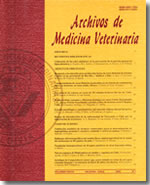How to obtain and isolate equine sternal bone marrow mononuclear cells with limited resources
Main Article Content
Abstract
Musculoskeletal injuries in horses are very frequent and lead to substantial financial losses. Bone marrow mononuclear cells (BMMNCs), the fraction of bone marrow containing mesenchymal stem cells, have been successfully employed to enhance healing of tendon, ligament and articular injuries in this specie. Many descriptions of how to harvest equine BM and isolate BMMNCs have been described; however, reported protocols consider fully equipped and costly laboratory facilities. The aim of this manuscript is to demonstrate to veterinary practitioners that obtaining and effective isolating equine BMMNCs for clinical use is possible with basic laboratory equipment. BM samples of 10 horses were collected from the 5th sternebra into 60 mL syringes containing heparin and Dulbecco's Phosphate-Buffered Saline (DPBS) using equipment that can be found in most equine clinics. Further, samples were centrifuged by density gradient for BMMNCs isolation within 1h after collection. Concentration and cell viability was determined by both direct counting on a Neubauer® chamber and epifluorescence analysis. Harvesting and isolation was achieved for all horses with no restrictions. The final 1 mL concentrate considered total number of BMMNCs (mean ± SD) and percentage of cell viability amongst isolates were 190±54 x 106 and 98±1.2%, respectively. Contamination was not observed in obtained samples and horses treated with BMMNCs using this technique did not present any clinical complications. Aspiration and processing of equine sternal BM using the described technique is a low cost and reliable method to obtain BMMNCs for cell based therapies.

